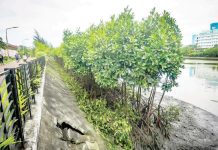
LAST Sunday, I was thrilled to stroll the boardwalk — that didn’t use any nails in its construction, says the sign — dedicated to appreciating the well-preserved and protected mangroves in Barangay Doljo, in Panglao, Bohol. Walking amidst the mangrove cover was both fantastic and heavenly! I can do it again!
I was awed by the mangrove trees whose ecosystem benefits the fishes and crustaceans in the locale. Truly, advocating the conservation of our mangroves in Bohol will make our province and people richer in natural resources. We can’t go wrong with that.
For those who grow up and reside in Bohol, we easily take for granted the significance of our mangroves because they have quietly and unobtrusively sprouted, flourished, survived, and thrived in coastal spaces over the years forming part of our environment sans our attention. They are just there. When you travel to Valencia, you see them in Baclayon, Alburquerque, and Loay. They are in Taloto, Tagbilaran City, and even along the highway in Mansasa before we turn towards Dauis. We spot them in Cortes and Maribojoc. They are all over our island province and I’m certain you have noticed them in the places you frequently traveled.
From the thrilling promenade, until we arrived at the makeshift quay, I can only marvel at the assemblage of mangroves with their distinctive interlaced roots that must have existed long before we were born providing stability to the coastline since they are well-adapted to the daily rise and fall of the tides. Hmm. I chuckle at the thought. If only we could be as “well-adapted to the daily rise and fall of the tides” in our mortal life we would be better individuals.
Bohol is an island province with fishing as a predominant means of livelihood and mangrove forests and their ecosystems are crucial habitats for fish, crustaceans, and other organisms seeking food and shelter.
I tried to look for a published study focusing on the mangroves in Bohol and I came across a paper, “State of the Mangrove in Bohol,” published online by Forester Restituto A. Piollo, Jr. and Forester Glicerita C. Racho. The study emphasized that mangroves are excellent breeding and feeding areas for fish and crustaceans. They protect against strong waves and storm surges. Meanwhile, “Ecotourism in mangrove areas — like the one I explored — serves as a livelihood activity in the province.” They include mangrove tours (along boardwalks), kayaking, stand-up paddling, canoeing, and firefly tours. Floating restaurants also tour the mangroves in the Loboc River.
Mangroves, being fascinating species, are also used as educational and research sites, and according to the study, Bohol has a “rich history of community-based forest management program like the Banacon Island which is the first recipient of the Certificate of Stewardship Contract in the 1980s.” Interestingly, the authors said the Banacon man-made mangrove forest is the first large-scale mangrove afforestation project in the Philippines, and probably in Asia.
The paper identified eighteen mangrove species and six mangrove associate species found in the province. These are Aegiceras corniculatum, Avicennia alba, A. marina, A. officinalis, Bruguiera gymnorrhiza, B. sexangula, Ceriops
decandra, C. tagal, Excoecaria agallocha, Heritiera littoralis, Lumnitzera racemosa, Nypa fruticans, Osbornia octodonta, Rhizophora apiculata, R. mucronata, R. stylosa, Sonneratia alba, and S. caseolaris. The mangrove associate species include Dolichandrone spathacea, Hibiscus tiliaceus, Ipomoea pes-caprae, Morinda citrifolia, Pongamia pinnata, and Terminalia catappa. We need to get acquainted with our mangroves!
Like anything that belongs to our natural environment, threats are also aplenty. These include coastal pollution, sand extraction, and pest infestation in newly-planted mangroves. Natural disturbances such as sea-level rise and earthquakes likewise endanger the survival of mangroves.
The study highlighted the 7.2-magnitude earthquake that hit Bohol on October 15, 2013, where “portions of the coastal areas in Tubigon and Inabanga were inundated by a few inches.” Additionally, “Around 129 hectares in Maribojoc and Loon were uplifted causing the mangroves to deteriorate and eventually die.” I recall a previous column written by a guest writer who visited Barangay Sag in Talibon, Bohol. He observed that the mangrove cover in Sag had thinned after typhoon Odette smacked the islet. I wonder if the island folks have started replanting.
Both authors recommended the enhancement of the mangrove stands, meaning, diversifying, and updating information on the actual mangrove cover and extent using a Geographic Information System. Information is power, so, an updated and accurate information bank is crucial. It was also underscored that reforestation in the province is limited to the use of Rhizophora species resulting in the neglect of other species.
Other recommendations include a) Setting up mangrove nurseries and mangrovetum (as a source of planting materials) in strategic sites; b) Observing site-species-matching and proper species zonation in mangrove reforestation projects; c) Stopping illegal activities such as mangrove cutting (Let’s all become advocates to preserve our environment.), conversion into different land uses (Do we seriously prevent this?), and improper garbage disposal (The inclination of Filipinos to consider every and any available space as a garbage area is legendary!); d) Strict enforcement of environmental laws, policies, and regulations (I can only hope that local government units and national agencies of government faithfully do this.); f) Seriously consider the carrying capacity, biodiversity, and conservation in developing tourism programs (So true!); and f) Continuous information, education, and communication advocacy on the importance of mangroves, encompassing the protection and preservation of coastal resources (No letup!).
Now, do I need to say more?
***
The writer hosts Woman Talk with Belinda Sales every Saturday, 10 a.m. at 91.1 Balita FM Tagbilaran City. Email at belindabelsales@gmail.com. X @ShilohRuthie./PN







